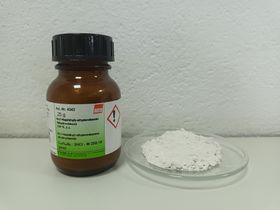N-(1-Naphthyl)ethylenediamine dihydrochloride
 Sample of the compound and original bottle.
| |
| Names | |
|---|---|
| IUPAC name
N1-(Naphthalen-1-yl)ethane-1,2-diamine dihydrochloride
| |
| Other names
N-1-Naphthyl-1,2-ethanediamine dihydrochloride
Naphthylethylenediamine dihydrochloride | |
| Properties | |
| C12H16N2Cl2 C10H7NHCH2CH2NH2·2HCl | |
| Molar mass | 259.18 g/mol |
| Appearance | Off-white powdered solid |
| Odor | Faint |
| Melting point | 194–198 °C (381–388 °F; 467–471 K) |
| Boiling point | Decomposes |
| 3 g/100 ml | |
| Vapor pressure | ~ 0mmHg |
| Hazards | |
| Safety data sheet | Sigma-Aldrich |
| Flash point | Non-flammable |
| Except where otherwise noted, data are given for materials in their standard state (at 25 °C [77 °F], 100 kPa). | |
| Infobox references | |
N-(1-Naphthyl)ethylenediamine dihydrochloride is an organic chemical compound, the most common form available of N-(1-naphthyl)ethylenediamine, as the dihydrochloride salt.
It is commercially available as part of Griess reagents, which find application in quantitative inorganic analysis of nitrates, nitrite and sulfonamide in blood, using the Griess test.
Contents
Properties
Chemical
Addition of sodium hydroxide or sodium alkoxide to this compound yields the N-(1-naphthyl)ethylenediamine freebase.
The compound readily undergoes a diazonium coupling reaction in the presence of nitrite and sulfanilamide, to give a strongly colored azo compound. This process is used to identify and measure the amount of nitrites in a water sample, by measuring the absorbtion of the resulting solution with a spectrophotometer.
Solution of N-(1-naphthyl)ethylenediamine dihydrochloride in sulfuric acid-methanol may be employed for the quantitation of sugars.
Physical
N-(1-Naphthyl)ethylenediamine dihydrochloride is an off-white or faint brownish solid, slightly soluble in water.
Availability
N-(1-Naphthyl)ethylenediamine dihydrochloride is sold by chemical suppliers, though it's not cheap.
Preparation
It can be prepared by reacting 1-naphthylamine with 2-chloroethanamine, followed by neutralization with HCl.
Projects
- Quantitative analysis of nitrate and nitrite in water samples
- Measure sulfonamide concentration in a solution
Handling
Safety
The compound is irritant and should be handled with care.
Storage
In closed bottles, away from polluted air (the NOx from air may produce nitrites which will contaminate its purity).
Disposal
Should be diluted with lots of water and poured down the drain.
Alternatively, it can be destroyed with an oxidizing mixture.